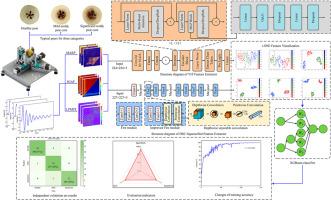Acoustic-vibration detection of moldy pear core: a novel approach combining image coding and hybrid deep learning
IF 6.3
1区 农林科学
Q1 FOOD SCIENCE & TECHNOLOGY
引用次数: 0
Abstract
The common acoustic-vibration detection technology for pears with moldy core had weak adaptive extraction ability and low accuracy in distinguishing early moldy pear cores. To address this issue, this study proposed an "single-point excitation and dual-point sensing" acoustic-vibration method combined with the image coding and hybrid deep learning model. The self-designed acoustic-vibration testing system was used to obtain the acoustic-vibration signals of pears. The acoustic-vibration signals were transformed into the feature images using the improved image encoding methods. Subsequently, the DSC-SqueezeNet feature extractor improved by the deep separable convolution (DSC) and the vision transformation (ViT) feature extractor was used to adaptively extract the deep features related to the moldy pear core. Then, the t-SNE method was used to perform the qualitative and quantitative clustering analysis on the deep features extracted by the two feature extractors. The quantitative analysis results showed that the deep features extracted by DSC-SqueezeNet from multi-scale asymmetric recurrence plots (MARP) feature images outperformed those extracted by ViT in terms of inter-class separation (DB = 0.1981) and intra-class compactness (CH = 4409.7842), and were more effective in characterizing the detailed information in the response signal images of the three pear categories. Finally, the deep features extracted from the optimal feature images were input into the two classifiers: multi-layer perceptron (MLP) and extreme gradient boosting (XGBoost). The hyperparameters of MLP and XGBoost classifiers were optimized by the Optuna algorithm to construct the DS-OPMLP model and DS-OPXG model for identifying the pears with moldy core. The classification results indicated that the DS-OPXG discrimination model established by the multi-scale asymmetric recurrence plots (MARP) as input has the higher classification accuracy of 95.83 % on the test set, which was 5.56 percentage points higher than that of the DS-OPMLP model. The sensitivity and specificity for the mildly moldy pear core were 96.15 % and 95.65 %, respectively. Also, the ablation experiments were executed to verify the effectiveness of the fusion of DSC and XGBoost. The DS-OPXG model only distinguished one mild moldy core pear as significant moldy core pear for the external validation set. The classification accuracy was 90.48 % for healthy pears, 97.44 % for the pears with mild moldy core and 86.49 % for the pears with significant moldy core. Therefore, the DS-OPXG model constructed by the MARP and hybrid deep learning can effectively capture the detail information of the acoustic-vibration signal and further improve the discrimination accuracy for the pears with the mild moldy core. This holds great significance for the practical application of acoustic-vibration detection of internal diseases in pears.

梨霉变核的声振动检测:一种结合图像编码和混合深度学习的新方法
常用的梨霉变声振检测技术对梨早期霉变的自适应提取能力较弱,识别准确率较低。针对这一问题,本研究提出了一种结合图像编码和混合深度学习模型的“单点激励双点传感”声振方法。利用自行设计的声振测试系统,对梨的声振信号进行了采集。采用改进的图像编码方法将声振动信号转化为特征图像。随后,利用深度可分离卷积(DSC)和视觉变换(ViT)特征提取器改进的DSC- squeezenet特征提取器自适应提取与霉变梨核相关的深度特征。然后,利用t-SNE方法对两种特征提取器提取的深度特征进行定性和定量聚类分析。定量分析结果表明,DSC-SqueezeNet从多尺度非对称递归图(MARP)特征图像中提取的深度特征在类间分离度(DB = 0.1981)和类内紧密度(CH = 4409.7842)方面优于ViT提取的深度特征,能够更有效地表征三种梨类响应信号图像中的详细信息。最后,将从最优特征图像中提取的深度特征输入到多层感知器(MLP)和极端梯度增强(XGBoost)两个分类器中。利用Optuna算法对MLP和XGBoost分类器的超参数进行优化,构建了DS-OPMLP模型和DS-OPXG模型,用于梨霉变核的识别。分类结果表明,以多尺度非对称递归图(MARP)为输入的DS-OPXG判别模型在测试集上的分类准确率为95.83%,比DS-OPMLP模型提高了5.56个百分点。梨核轻度霉变的敏感性和特异性分别为96.15%和95.65%。通过烧蚀实验验证了DSC与XGBoost融合的有效性。DS-OPXG模型在外部验证集上仅将一个轻度霉变梨区分为显著霉变梨。对健康梨的分类准确率为90.48%,对轻度霉变核的分类准确率为97.44%,对显著霉变核的分类准确率为86.49%。因此,基于MARP和混合深度学习构建的DS-OPXG模型可以有效捕获声振信号的细节信息,进一步提高对轻度霉变梨的识别精度。这对梨内部疾病的声振检测的实际应用具有重要意义。
本文章由计算机程序翻译,如有差异,请以英文原文为准。
求助全文
约1分钟内获得全文
求助全文
来源期刊

Food Control
工程技术-食品科技
CiteScore
12.20
自引率
6.70%
发文量
758
审稿时长
33 days
期刊介绍:
Food Control is an international journal that provides essential information for those involved in food safety and process control.
Food Control covers the below areas that relate to food process control or to food safety of human foods:
• Microbial food safety and antimicrobial systems
• Mycotoxins
• Hazard analysis, HACCP and food safety objectives
• Risk assessment, including microbial and chemical hazards
• Quality assurance
• Good manufacturing practices
• Food process systems design and control
• Food Packaging technology and materials in contact with foods
• Rapid methods of analysis and detection, including sensor technology
• Codes of practice, legislation and international harmonization
• Consumer issues
• Education, training and research needs.
The scope of Food Control is comprehensive and includes original research papers, authoritative reviews, short communications, comment articles that report on new developments in food control, and position papers.
 求助内容:
求助内容: 应助结果提醒方式:
应助结果提醒方式:


